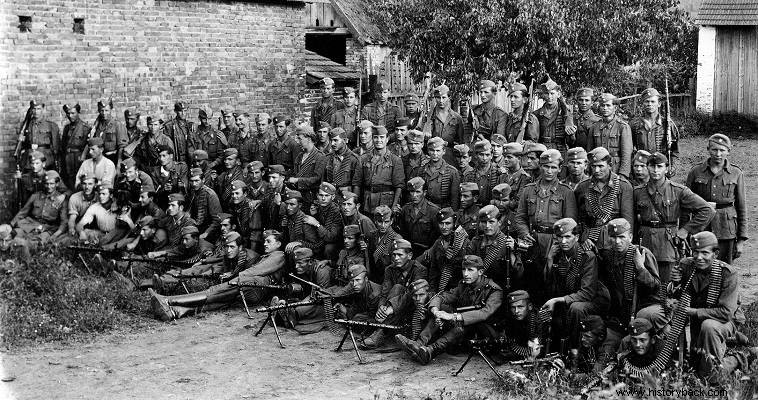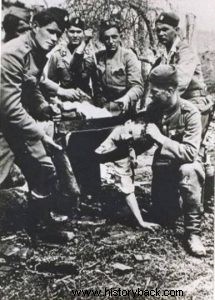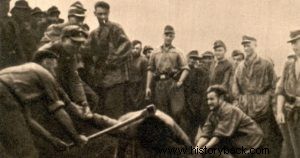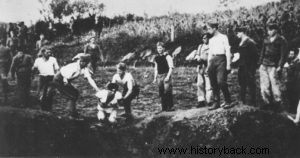
On April 6, 1941, the Germans attacked Yugoslavia. The Croats saw the German attack as an opportunity to liberate themselves from Yugoslavia, which they had joined, not so willingly, after World War I.
On April 10, 1941, in Zagreb, Ante Pavelic, the head of the fascist Croatian separatist organization Ustasha, returned from Italy, where he lived, Mussolini's crew, undermining Yugoslavia. Pavelic was declared "leader" (Poglavnik - a term equivalent to the German Führer and the Italian Duce).
Pavelic installed the Ustasi regime, which is responsible for the extermination of at least 2,000,000 Serbs and many thousands of Jews and Gypsies, with the assistance of the Roman Catholic Cardinal Stepinac of Croatia, who was canonized by the Vatican relatively recently.
The first military formation organized by the Pavelic regime was the Poglavnik Guard Battalion, which gradually rose to division level. Initially the battalion consisted of 200 men, but soon exceeded 1,000.
And so great was the turnout of volunteers that, by December 1941, three battalions had been formed – two in Zagreb and one in Banja Luka – a field battalion, a motorized group, a cavalry brigade of three ils and an artillery squadron of two artillery pieces.
Consequently, the title of the unit was changed and it was called Poglavnik's Guard Brigade. Later the two cavalry islands and one artillery were abolished.
In October 1943 the Brigade was reorganized to include three battalions of 1,200 men each, three field battalions of 500 men each, three cavalry companies, a tank company with Italian CV-35 tanks and an artillery company with 75mm mountain guns.
In 1944 the Brigade became a Division. Two infantry regiments were then formed, each with four infantry battalions, while the Division also had three artillery companies, a motorized company, a light tank company and a cavalry division. It also had two field battalions and services.
Later that year, the infantry was organized on the German model, into regiments of three battalions, with a further heavy weapons company – with a mortar platoon, an anti-tank platoon and two machine gun platoons.
Also the artillery was organized into a squadron with four artillery divisions (16 guns and light howitzers), while a reconnaissance division was formed with a company of 15 light tanks, two motorcycle companies and a motorized infantry company.
An armored group consisting of a medium tank company (15 tanks), a light tank company (7 tanks) and two motorized infantry companies was also formed. In April 1945 the Division had 10 battalions, organized into three regiments, three artillery battalions, two with 100cm guns and one with 7cm guns, as well as the above-mentioned tanks and motorized infantry.
The Guards Division was originally composed of men who had served in the Yugoslav Army and fought based on their training. Later German instructors took over the training and the men were trained in German tactics.
Their equipment also came from the spoils of the Yugoslav Army, but Italian and then German weapons were also available. Although the unit was supposedly formed to guard Pavelic, it saw action as early as August 1941.
Throughout the war the Guards Division undertook "anti-partisan" duties, fighting against Colonel Mihajlovic's Chetniks and then Tito's partisans, but also committing horrific crimes against the Croatian Serbs, whom Pavelic wished to disappear from the face of the earth.
The Ustasi proved to be even worse than the SS, on occasion, murdering indiscriminately every non-Croatian and Roman Catholic man, woman and child that fell into their hands.
Although the men of the Division were, supposedly, a regular force, not related to the Ustasi militia that had undertaken the task of "cleansing" and they did not lag at all in the murderous work, taking part, on the side of the Germans, in dozens of operations against the rebels, during which thousands of people were killed.
The first large-scale massacre occurred on November 19, 1941, when 800 Serbs of all sexes and ages were massacred. In February 1942, more than 2,100 Serbs were murdered with shovels, knives and axes, under the supervision of the Brigade's Roman Catholic priest Vjekoslav Filipovi. Similar massacres took place until the end of the war.
Although Pavlić did not suffer the fate he deserved, most of the men of the Division were captured by Tito's men and executed, in many cases in particularly gruesome fashion, by partisans who had lost their families to the Croats.
Knowing the fate that awaited them, many Croats continued to fight until May 22, 1945, several days after the official end of World War II in the European theater of operations.



